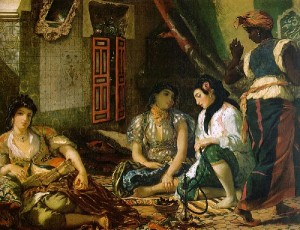Some aspects of the History of the XXth Century are explicitely used as inspiration, although they will be altered to fit the narration, since Harem Son Saat is not meant to be a fully realistic game.
The Harem culture
Harem means « forbidden to men », and the term was coined to describe the group of women surrounding an important character. Over the course of the period, it is an extremely hierarchized place, following strict rules. Only women, children and eunuchs were allowed there, or close male relatives. The rules applied to all, Sultan included.
The hierarchy was defined as such: the lowest rank was slave, then favorite, then concubine (once they became a mother), then spouse when they got in favor and were mother to a Prince. The head of the Harem is the Valide Sultane, mother to the Sultan, who is all-powerful there.
The purpose of the Harem is not sexuality, but providing an heir. As such, it is a political tool. The smart woman can become a favorite, mother to an heir, and influence the ruler. Competition between women, especially mothers of Princes, was brutal. The eldest Prince was always the presumed heir, but exceptions were frequent, any male heir could become the next Sultan. Once a new Sultan rose to power, all of his brothers would be executed to prevent succession conflicts.
The Harem is a siege of intrigue and competition. As such, women of the Harem were well educated, as possible mothers to the Sultan, they had knowledge and oratory skills. Women were taught in the Harem, in expression, writing, music and foreign languages.
Muslim women could not become slaves, therefore women of the Harem were usually of Eastern European or Caucasian origin, but would usually convert to Islam once they became concubines. Sultans in the Ottoman Empire have all had both a European and Eastern origin. Some of the most talented slaves could rise high in favor, the most famous being Hürrem, favorite concubine to Suleiman the Magnificent in the XVIth century, at the peak of the Empire’s power.
However, at the beginning of the XXth century, the Empire is in decline. In Istanbul, the nationalists rule and only pay lip service to the Sultan’s authority. The Harem in Istanbul was closed soon after, disappearing in 1912. Messages were sent to the families of the women that were there, offering to send their daughters back to them. However, most women refused to leave, or expressed their sorrow at having to, since they would leave the Palace and Court life to return to what often amounted to miserable living conditions.
Orientalist art
Over the course of the XIXth century, orientalist art was developed following a mix of travelers’ tales and idealized images of the East.
The Harem, opposed to a monogamous Christian tradition, became the subject of many fantasies and representations, around the idea of what was socially forbidden.
Whether or not the Ottomans themselves were aware of these ideas could be argued. However, it is probable that these representations influenced the attitude of Western sensitivities towards the Empire. The Ottoman Empire, sometimes dubbed the “Sick Man of Europe”, still held a lot of influence and fascination before its downfall in 1918.
The Balkan powder keg
The instability in the Balkan area serves as a backdrop to the drama of the Ottoman Empire and remains one of the main causes of World War One. The disintegration of the Ottoman Empire in Eastern Europe started with the “awakening of nationalities”. In the beginning of the XIXth century, Greece, Serbia and Romania become independent countries. The creation of these new monarchic States is encouraged by the European powers that wishes to tear down the “sick man of Europe”. Competition runs wild between Russia, Germany, France and the United Kingdom for control over the Balkan space where roads of a great geostrategic importance converge. Russia supports Orthodox States, whereas Austria-Hungary controls Slovenia, Croatia and Bosnia. The murder of prince Franz Ferdinand by a Serbian nationalist on the 28th of June 1914 marks the beginning of the First World War.


